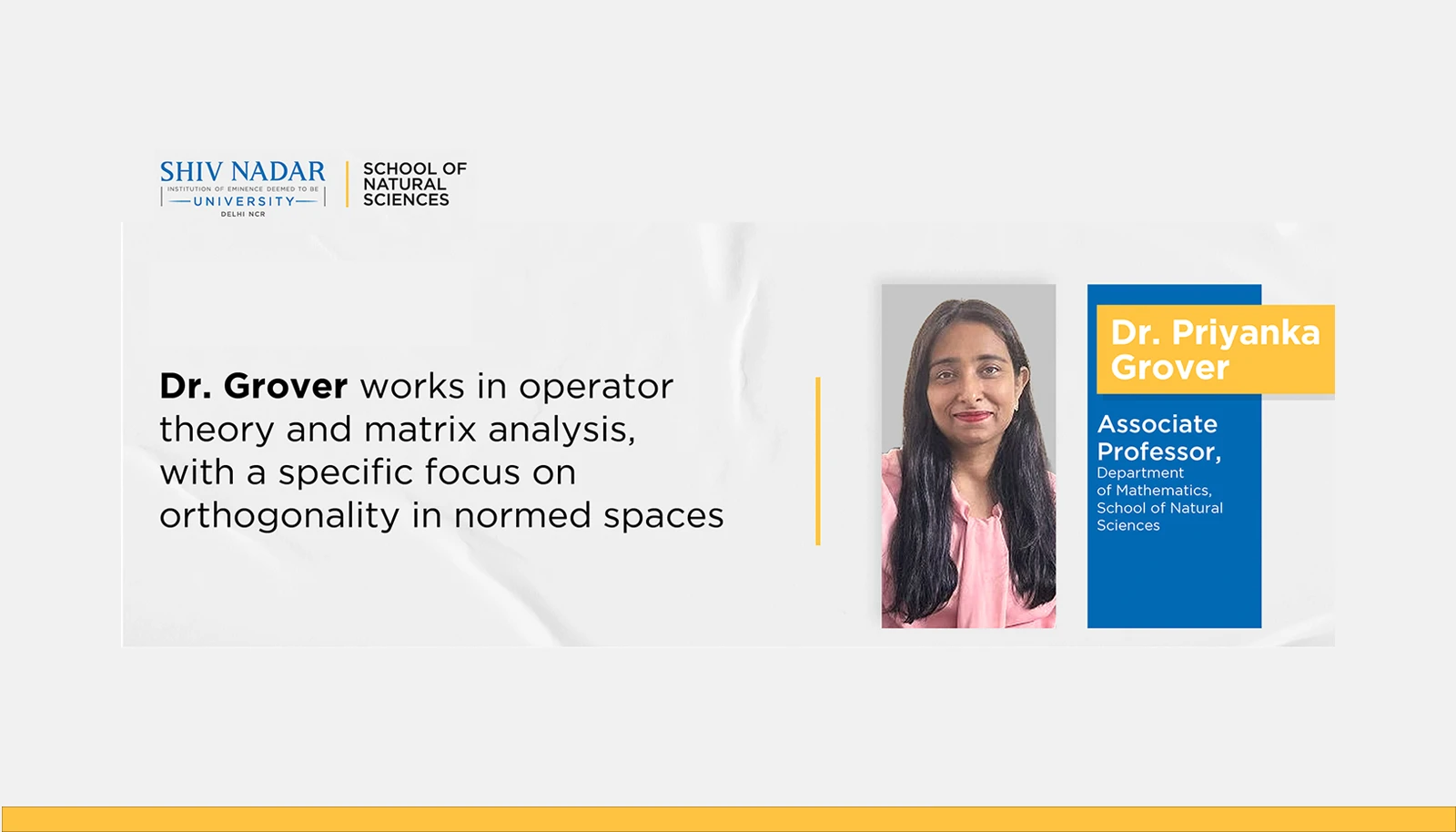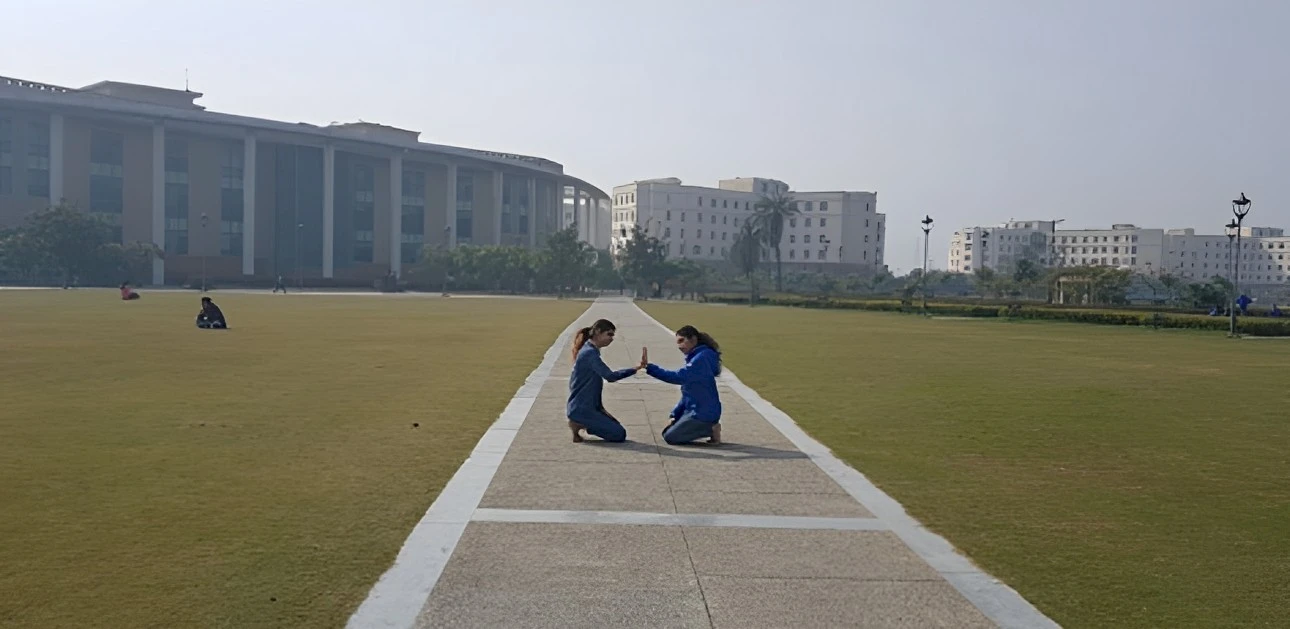Understanding Orthogonality in Normed Spaces

Editorial / May 15, 2025
Why does your favourite online streaming platform always seem to know what to play next? Behind the scenes, complex mathematics—especially from fields like operator theory and matrix analysis—helps make those predictions. At the Department of Mathematics, School of Natural Sciences, Dr. Priyanka Grover is advancing research in these areas, particularly in the study of orthogonality in normed spaces.
One of the first vector operations we learn at school is the dot product—a way to measure how much two vectors are oriented towards the same direction. At a basic level, this dot product gives you an idea of the angle in between the vectors. When the dot product is zero, the vectors are at an angle of 90° to one another, and they are said to be orthogonal.
In higher mathematics, there are many ways to interpret the orthogonality of vectors, some of which can go beyond our physical understanding of an angle. One of the places this happens are in ‘normed spaces.’
A normed space is a vector space for which an additional mathematical structure called a ‘norm’ can be defined. The norm is a way to quantify the length (i.e., magnitude) of a vector in the form of a function. “It’s possible to explain orthogonality through the lengths of the vectors instead of going through angles, and then you come across different mathematical properties,” explains Dr. Grover. “So far, we are in the process of mathematically understanding how orthogonality can be generalised in various settings using the concept of the norm.”
Generalisation can be thought of as identifying the core mathematical properties in one class of objects that also hold true for a different or more expansive class of objects. One such class is that of Banach spaces, and one such concept of orthogonality is known as Birkhoff–James orthogonality—which helps mathematicians understand when two vectors are ‘independent’ of each other in a different way.
“At present, the theory stands at understanding the structures of mathematical objects through Birkhoff–James orthogonality,” clarifies Dr. Grover. All mathematical spaces can be equipped with structures that give them additional features. “One of the recent directions has been towards classifying something called ‘C* algebras,’ which are a type of algebra that pertains to Banach spaces,” she continues.
Classification is a way to sort mathematical objects into different groups based on some common properties. Recently, Dr. Grover has received a SERB Core Research Grant along with Prof. T.S.S.R.K Rao of the School of Natural Sciences, on the ‘Classification of Banach spaces using differentiability.’
The Birkhoff–James orthogonality can be viewed as an approximation problem, which in turn can be dealt with through the ‘differentiability’ of the norm. Since norms are functions, its value changes depending on the value of the vector input. The rate of change of a function with respect to an input variable is called its derivative. Imagine it like drawing a straight line that just touches a curve at one point; that line shows how steep the curve is at that spot. When this can be done at every point on the curve, the function is said to be differentiable.
But sometimes, the curve has sharp corners or jumps, and a clean line can’t be drawn. In some cases, we use a broader idea called subdifferentiability, which helps us study how the function behaves even when it's not smooth. All the possible directions in which the function can change at that point make up what's called the subdifferential.
“There is a lot of research happening in understanding different Banach spaces with different structures, each of which have a norm on them. Once we have the subdifferential set for these different settings, we can characterise approximation problems,” says Dr. Grover.
One of Dr. Grover’s former Ph.D. students, Dr. Sushil Singla, recently used the concepts of subdifferentiability and differentiability to classify C* algebras. Dr. Singla is presently a Pacific Institute of Mathematical Sciences postdoctoral fellow at the University of Regina, Canada. In 2024, Dr. Grover and Dr. Singla won the P. K. Jain Award from the Indian Mathematical Society for work done during his thesis under Dr. Grover.
Dr. Grover has won many other accolades in the ten years since she completed her Ph.D. in 2014, including a SERB Early Career Research Award and DST–INSPIRE Faculty Award. In 2022, she was chosen to be a young Associate of the Indian Academy of Sciences. She also enjoys other interesting problems, such as studying positivity properties of interesting matrices and norm inequalities related to matrix geometric mean. Her research, while theoretical, could have applications in many fields—from physics and engineering to data analysis, medical imaging, and machine learning. We look forward to seeing what she does next!
More Blogs

The Hawthornden Literary Retreat bestowed on Dr Sambudha Sen to complete the manuscript of a novel
Professor Sambudha Sen, Head of the Department of English at Shiv Nadar Institution of Eminence, Delhi-NCR, was awarded a residency at the...

The Power of the Moving Body
Movement is an innate bodily action that humans have been exhibiting for the longest time. Long before language was invented, the body was the...

How Does A Multi-Disciplinary Approach To Education Enhance Learning And Prepare Students For A Multi-Faceted World?
In today’s world, where businesses are changing almost every day, it is the responsibility of educational institutes to provide holistic...